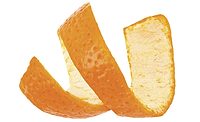Controlling Orange Peel's Impact On Today's Brilliant Auto Finishes

Any way you look at it, orange peel is bad news. When a car rolls off the assembly line with this wavy, light-and-dark pattern hiding somewhere in the paint, the only good news is that it was caught. Otherwise it would have been received by the dealer or even a consumer and caused considerable dissatisfaction. That would be even more expensive than sending it to the rework department in the first place. You could also add to those problems the potential losses in scrapped products, and the possibility that paint is being wasted because of overkill in the spray booth.
Bill Bastian, transportation sales manager at BYK-Gardner, says the orange peel phenomenon is by no means restricted to passenger cars. It is a crucial concern for manufacturers of SUVs, motor homes and luxury buses, and is gaining attention in the pleasure boat and aircraft markets. In short, more people are requiring a great paint job.
"There was a time when a truly high-quality car finish meant 12 coats of hand-rubbed lacquer," he says. "Today's car buyer expects a flawless finish right off the production line, which requires sophisticated painting systems and precision quality controls."
The "wetness" of today's shiny paint jobs is not the result of paint alone. A high-quality finish depends on what coatings experts call "distinctness of image." So, while paint makers have succeeded in developing very high gloss liquid coatings, there are still underlying problems in controlling waviness (orange peel) in the final appearance of finishes.
"Each layer of paint - e-coat, primer, topcoat and clearcoat - must have a smooth, lustrous appearance, as well as the requisite physical and chemical properties," Bastian says. "This is not easily achieved, since vehicle parts have varying contours and the sheet metal from which they're made has an uneven texture from the stamping process."
Also, the painting process must accommodate varying contours and orientations, including straight, curved, horizontal, and vertical.
Add to that the fact that automakers are shifting to powder coatings to comply with the EPA's year-2003 ban on the VOCs found in liquid paint. Powder coatings differ in rheology (deformation and flow) from today's liquid paint. Most automakers don't yet have a lot of experience in applying powder coatings to car finishes. Chrysler, GM and Ford are working together in the Low Emissions Paint Consortium (LEPC) to develop application techniques and finish standards from powder coatings.
"There's a lot more to this than just paint," says Brian Prylon, GM staff engineer with the LEPC at the Wixom, MI, Ford assembly plant. "Converting to powder coatings also involves new painting tools, filtration processes, the entire painting system." All of which makes powder painting with little or no orange peel - a most noticed appearance factor - a daunting challenge.
One of the tricky aspects of detecting and measuring orange peel is that it is a visual, not tactile, phenomenon. In an effort to better define this, BYK-Gardner conducted studies on the affects of substrate roughness and paint rheology on appearance. The company used its Wave-Scan Plus, a hand-held meter that was designed specifically to evaluate orange peel by taking laser-optical reading measurements on the finished surface. Orange peel was traditionally evaluated using samples with varying degrees of orange peel, or by profilometry, a laboratory process that measures the texture of the painted surface.
Using three different paint systems and substrates with varying textures, test panels were subjected to different paint processes and baking positions. Then the instrument's laser light took a measurement every 0.08 mm for scan lengths of 10 cm on the painted surfaces, resulting in 1,250 measuring points per scan. Measurements of waviness were automatically correlated in mathematical terms to other industry-known, visual measurement scales including tension value and orange peel standard ranking. This also provided an indirect measure of orange peel-influencing factors such as substrate roughness, flow/leveling properties of paints and process parameters.
The test concluded that changes in short-term waviness - the condition that causes the most noticeable orange peel - are caused by sheet metal roughness and the use of a clear (top) coat. The less noticeable long-term waviness is affected mainly by baking position. The test results also indicated that there is a need to measure for orange peel on a continuous basis and take corrective action as necessary.
The importance of the instrument's measuring long- and short-term waviness is to simulate the resolution of the human eye, or what you see. The profilometer, on the other hand, measures microscopic topography, or what you feel. The other quality control measure included placing cameras on the assembly plant finishing line to record and analyze the gloss. These visual assessments were quite subjective, based on comparing the final paint job with orange peel samples of varying degrees. The instrument provides a more objective eye for the assessment of appearance.
The instrument is battery powered, so it can be used at any location without the interference of cables. It is easy to operate; user-definable displays permit guided operation according to the user's measurement sequence. The instrument is reliable and self-calibrating; reproducible results are achieved on test panels or curved surfaces, whether on solid or metallic paint.
The instrument is in wide use among automakers today, including manufacturers of European prestige models like Mercedes, BMW, Jaguar and Rolls Royce. According to Bill Bastian, Toyota uses the device in the production of its Lexus and Camry models, which "are setting the benchmarks for paint quality in the automotive industry."
Bastian says the Wave-Scan Plus is becoming popular in the luxury bus industry as well, and is used by Boeing and Cessna for evaluating aircraft finishes.
Links
Looking for a reprint of this article?
From high-res PDFs to custom plaques, order your copy today!





